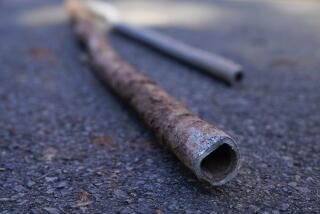PLUMBING : There’s a Pipe for the Job, Whether Water Is Incoming or Outgoing
- Share via
Every home has two completely separate water systems.
A supply system delivers clean, fresh water. A drain system (drain, waste and vent, called DWV by the professionals) channels waste water downward through the house to the sewer below.
Increasingly, the fresh water supply to new houses comes through plastic pipes, but metal pipes--copper, brass or galvanized steel--are still commonly found in both new and old homes.
Copper Pipe
Copper pipe for plumbing has many advantages. It’s light and durable, resists mineral deposits, can be used with either mechanical or soldered connectors and is convenient to work with, add to and repair. It’s softer than steel, so a plumber can quickly cut it with an inexpensive tube cutter or hacksaw.
To join copper, a plumber usually solders the joints--or “sweats” them. Earlier solders were half tin and half lead. Today’s solder is a safer combination of 95% tin and 5% antimony, both of which bond to copper and melt easily.
Sweat-soldered copper joints are stronger and less likely to leak than mechanical connections.
To sweat solder, polish the end of the pipe and the inside of the fitting with steel wool. Apply soldering paste (a noncorrosive flux, or substance used to help metals fuse together) to the pipe and fitting. Insert the pipe and turn it to spread the flux.
Holding solid solder wire to the joint, heat the fitting with a propane torch. The solder will be drawn into the joint. Stop when an even bead of solder appears around the joint.
Brass and Galvanized Steel Pipe
Because they can withstand tremendous pressure, brass and galvanized steel pipes are well suited for use in water supply systems. Brass pipe lasts longer than steel and resists buildup of deposits, but it’s expensive.
Both types are easily joined with threaded fittings. You can usually buy lengths of prethreaded pipe or have your supplier thread the pipe for you. Before joining threaded pipe, brush the threads with joint compound or wrap pipe tape around them to make them watertight.
Galvanized steel pipe supplied water to America’s faucets for more than half a century until copper took over during the 1960s. The steel pipes were supposed to last only 20 to 30 years, but in many houses they’ve lasted twice as long.
However, they rust and eventually spring leaks. They also allow mineral deposits to build up inside. This reduces their inside diameter and results in less water pressure at the faucets.
DWV Pipes
For drain, waste and vent, or DWV pipes, cast iron used to be standard. If you live in a house that’s more than 25 years old, you can usually spot that rough, black-painted or rust-colored pipe under the house or in the basement.
Cast iron is so hard that it is difficult to cut--although, with effort, you can cut it with a hacksaw. Plumbers commonly score it with a hammer and chisel until the pipe breaks off. Or they use a special tool called a chain cutter that wraps around the pipe to make a clean break.
Cast iron doesn’t corrode easily, and it lasts a long time. Older cast-iron pipes have overlapping hub joints that are joined by molten lead. Repairs to these pipes should always be done by a professional. Newer cast-iron pipes are joined with plastic sleeves that are clamped onto the pipes.
In new residential construction, however, cast-iron pipe has been almost entirely replaced by plastic pipe, which is much easier to handle.
More to Read
Inside the business of entertainment
The Wide Shot brings you news, analysis and insights on everything from streaming wars to production — and what it all means for the future.
You may occasionally receive promotional content from the Los Angeles Times.










